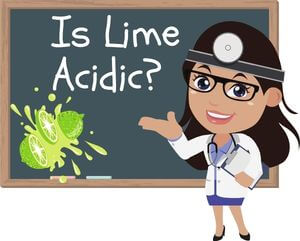Lime is a sour, light green, and round citrus fruit that serves as an excellent source of vitamin C. Like numerous other citrus fruits, lime is a great ingredient in cooking. Apart from being used in making certain pastries and drinks, it still has a lot of benefits. Limes have numerous species, including Persian lime, key lime, and makrut lime.

Each of these species has peculiar characteristics. For example, the key lime is smaller and acidic than the Persian. Although it is a citrus fruit with an enticing aroma and high acidity, many people may not know how peculiar lime is. In this article, we have provided you with an overview of the nutritional benefits of limes, their acidic nature, alongside possible side effects.
Is Lime Acidic? Yes, it is! Limes are very acidic fruits. They’re the only fruits with a higher concentration of citric acid. Most of the time, lime juice is often overly acidic, causing a very sharp bitter taste. A substance is said to be acid if it has a pH of less than 7 on the pH meter, and the closer the pH to zero, the more acidic the substance is. The pH of a lime lies between 2.0 and 3.0 on the pH scale, indicating that it’s very high in acid.
Is Lime More Acidic Than Lemon?
Yes. Even though both fruits have similar pH ranges, it has been proved that lime is more acidic than lemon due to slight differences in their pH values. According to chemical experts, lime has a pH between 2.0 and 2.36, while lemon’s pH falls between 2.0 and 2.70. Therefore lemon has a sour, acidic taste while lime has a bitter, acidic taste.
How Much Acid Is in a Lime?
The main acidic component in lime is “citric acid,” also contained in many citrus fruits. It’s also responsible for the tartness of lemon. Nitric acid makes up 6-8% of the whole fruit.
Is lime bad for your teeth?
The truth is that intermittent exposure to acidic foods can wash away your enamel, making teeth more liable to decay over time. So while a pinch of lemon or lime can turn a simple glass of water into a fun drink, it’s not always the best choice for your mouth.
What Are the Health Benefits of Lime?
The peculiarity of lime lies in its very high vitamin C and citric acid content. These two elements have many benefits on the body and can actively support the action of certain digestive organs. Here are the main benefits of lemon on the body and recognized by science:
Lime Can Reduce the Risk of Obesity
Like warm lemon water, a glass of warm water with the juice of a lime acts as a refreshing, antioxidant-rich drink that can contribute to weight loss. This is because the citric acid in lime juice can help the body burn fat. Lime juice, in general, is a healthy, weight-conscious option compared to traditional fruit juices like orange juice, as it is very low in calories and sugar in vitamins.
By switching from sweeter, higher-calorie juices and drink options to lime juice, you can almost get the body to settle for a tasty, sweet drink without those extra calories!
Limes Can Lower the Risk of Diabetes
Citrus fruits, including limes, are considered a “superfood” when treating diabetes. This is because the high soluble fiber content in limes helps regulate the body’s sugar absorption in the blood and reduces the risk of a blood sugar spike. This soluble fiber is found in the peel, juice, and pulp of limes, so the more fruits you can eat, the better. Soluble fiber can also lower blood pressure and lower the “bad” LDL cholesterol, clog arteries. Limes’ low glycemic index also means the fruit won’t cause unexpected spikes in glucose levels.
Limes Promote Heart Health.
The soluble fiber in limes, which can help people with diabetes maintain blood sugar levels, is also known to clear out LDL cholesterol, known as “bad cholesterol,” and lower blood pressure. It is also known to reduce inflammation of blood vessels, which can help prevent heart disease, heart attacks, and strokes. Limes are high in vitamin C, which is linked to a reduced risk of cardiovascular disease, while low levels of vitamin C in the blood are linked to an increased risk of stroke.
Lime Increases Iron Absorption.
One of the most common nutritional deficiencies in the developed world is iron, a major cause of anemia. Foods high in vitamin C, such as lime, can be combined with foods that contain iron to maximize the body’s ability to absorb dietary iron. This can be accomplished by drinking lime juice with an iron-rich meal or adding lime to a meal with iron-rich foods. Ferrous foods include red meat, poultry, seafood, beans, and dark green leafy vegetables like spinach.
For more information visit: Properties and Benefits of Lime

FAQ About Lime
Does Lime Help in Weight Loss?
Yes! A glass of warm water with lime juice contained in it is an excellent weight reducer and a refreshing, antioxidant refreshing drink. The citric acid present in lime is a superb fat burner. You can consume two glasses a day and see legitimate and noticeable results in a week. Some people also have long-term weight loss advantages by simply sucking on a wedge of lime half an hour before a meal.
Can Lime Be Used as Preservatives?
Due to their high acidity, limes can neutralize the effect of harmful bacteria found in foods that have been stored incorrectly. Experts have found that the juice added to food strongly protects against many terrible diseases. Then, you can add fresh lime juice to your dishes which stay out of the refrigerator for a long time to protect against bacteria. While it is highly unlikely that you will fight cholera, staph, and malaria in your “clean” home, studies clearly show that this fruit can kill bacteria and has powerful impactts on our immune system and overall health.
What Are the Side Effects of Lime?
Firstly, it is important to remember: all products are good when used in moderation. Lime, like many other citrus fruits, can cause allergies. The second risk is the softening of tooth enamel and caries. Acidic foods, including citrus juice, do not have positive affect teeth. After eating fruit or acidic juices, it is recommended that you rinse your mouth with clean water.
Some people may experience acid reflux when eating limes or drinking the juice due to its acidity. Other digestive symptoms can include acid reflux or heartburn, nausea, vomiting, and difficulty swallowing. Limes are very sour and best enjoyed in moderation.
Who Should Not Consume Lime?
Although lime helps treat kidney stones and is good for the healthy function of the kidney, people suffering from kidney disease should not consume lime to avoid renal damage. Lime contains a high amount of potassium, which is bad for people suffering from chronic kidney disease because the diseased kidney will not maintain the balance between the body fluids and the potassium content, thereby leading to abnormal potassium levels in the body.
Additionally, since excessive consumption of lime can harm the stomach, it’s advisable for women to do away with lime during the pregnancy period to avoid a direct impact on the baby in the womb. Moreover, stomach ulcer patients are strongly advised to stay away from lime. This is because the citric acid contained in lime can aggravate and worsen the condition.
Can a Bad Lime Make You Sick?
Can a bad lime make you sick? Some side effects like nausea or general weakness are possible, especially if you have a weak stomach or are sensitive to bad food. However, truly unpleasant consequences are not possible unless you eat a lot of limes at once, which is almost impossible.
Conclusion
Drinking lime water improves digestion. Limes are acidic and help saliva splits food into simpler form food for better digestion. In addition, the flavonoids contained in limes stimulate the production of digestive juices. If you suffer from constipation, the acidity of limes can clear the excretory system and stimulate bowel activity.
